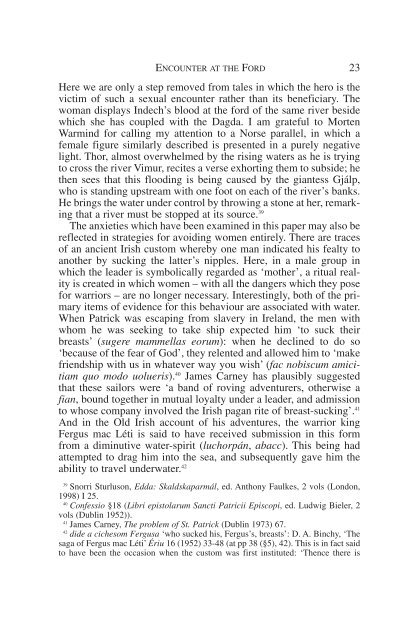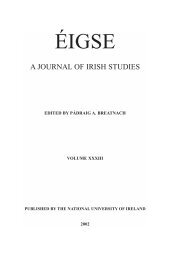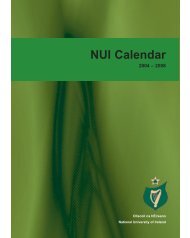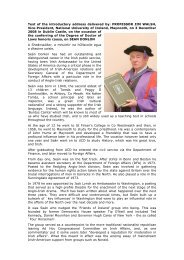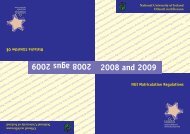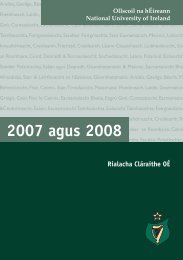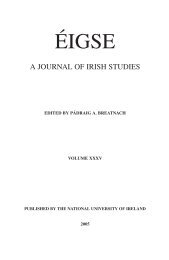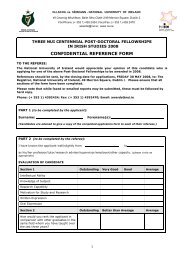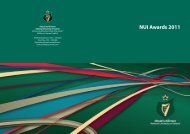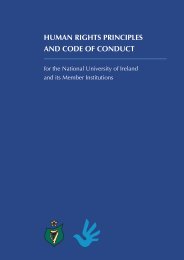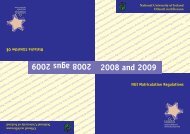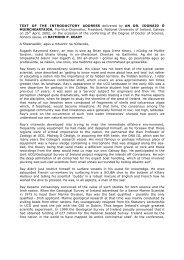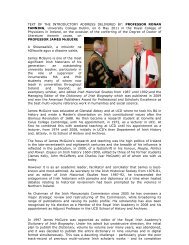Eigse Paged 2004 - National University of Ireland
Eigse Paged 2004 - National University of Ireland
Eigse Paged 2004 - National University of Ireland
Create successful ePaper yourself
Turn your PDF publications into a flip-book with our unique Google optimized e-Paper software.
ENCOUNTER AT THE FORD 23<br />
Here we are only a step removed from tales in which the hero is the<br />
victim <strong>of</strong> such a sexual encounter rather than its beneficiary. The<br />
woman displays Indech’s blood at the ford <strong>of</strong> the same river beside<br />
which she has coupled with the Dagda. I am grateful to Morten<br />
Warmind for calling my attention to a Norse parallel, in which a<br />
female figure similarly described is presented in a purely negative<br />
light. Thor, almost overwhelmed by the rising waters as he is trying<br />
to cross the river Vimur, recites a verse exhorting them to subside; he<br />
then sees that this flooding is being caused by the giantess Gjálp,<br />
who is standing upstream with one foot on each <strong>of</strong> the river’s banks.<br />
He brings the water under control by throwing a stone at her, remarking<br />
that a river must be stopped at its source. 39<br />
The anxieties which have been examined in this paper may also be<br />
reflected in strategies for avoiding women entirely. There are traces<br />
<strong>of</strong> an ancient Irish custom whereby one man indicated his fealty to<br />
another by sucking the latter’s nipples. Here, in a male group in<br />
which the leader is symbolically regarded as ‘mother’, a ritual reality<br />
is created in which women – with all the dangers which they pose<br />
for warriors – are no longer necessary. Interestingly, both <strong>of</strong> the primary<br />
items <strong>of</strong> evidence for this behaviour are associated with water.<br />
When Patrick was escaping from slavery in <strong>Ireland</strong>, the men with<br />
whom he was seeking to take ship expected him ‘to suck their<br />
breasts’ (sugere mammellas eorum): when he declined to do so<br />
‘because <strong>of</strong> the fear <strong>of</strong> God’, they relented and allowed him to ‘make<br />
friendship with us in whatever way you wish’ (fac nobiscum amicitiam<br />
quo modo uolueris). 40 James Carney has plausibly suggested<br />
that these sailors were ‘a band <strong>of</strong> roving adventurers, otherwise a<br />
fian, bound together in mutual loyalty under a leader, and admission<br />
to whose company involved the Irish pagan rite <strong>of</strong> breast-sucking’. 41<br />
And in the Old Irish account <strong>of</strong> his adventures, the warrior king<br />
Fergus mac Léti is said to have received submission in this form<br />
from a diminutive water-spirit (luchorpán, abacc). This being had<br />
attempted to drag him into the sea, and subsequently gave him the<br />
ability to travel underwater. 42<br />
39<br />
Snorri Sturluson, Edda: Skaldskaparmál, ed. Anthony Faulkes, 2 vols (London,<br />
1998) I 25.<br />
40<br />
Confessio §18 (Libri epistolarum Sancti Patricii Episcopi, ed. Ludwig Bieler, 2<br />
vols (Dublin 1952)).<br />
41<br />
James Carney, The problem <strong>of</strong> St. Patrick (Dublin 1973) 67.<br />
42<br />
dide a cichesom Fergusa ‘who sucked his, Fergus’s, breasts’: D. A. Binchy, ‘The<br />
saga <strong>of</strong> Fergus mac Léti’ Ériu 16 (1952) 33-48 (at pp 38 (§5), 42). This is in fact said<br />
to have been the occasion when the custom was first instituted: ‘Thence there is


